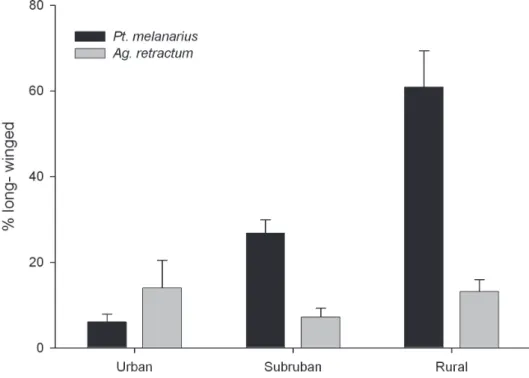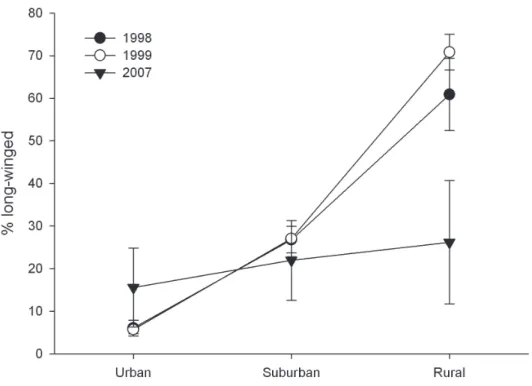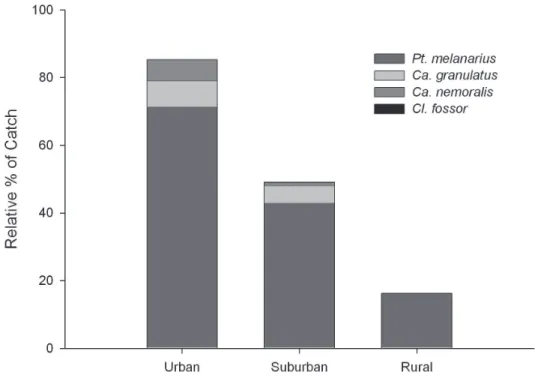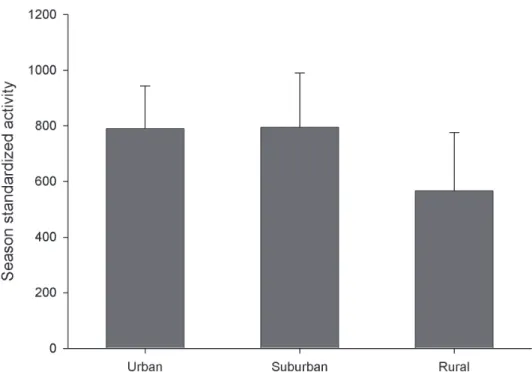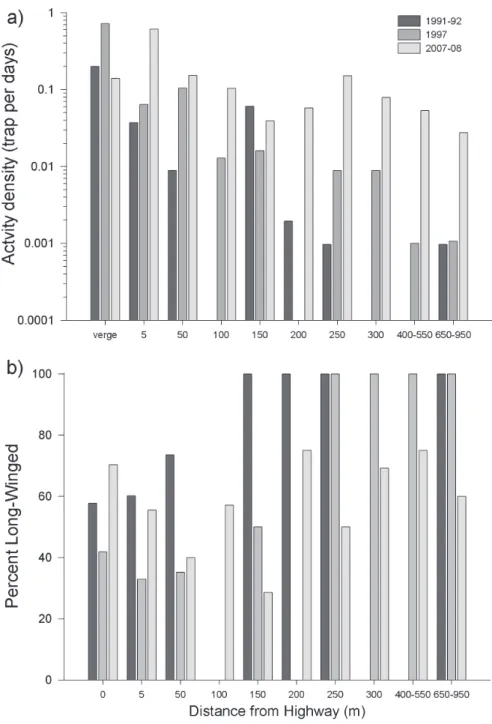Wing-dimorphism and population expansion
of
Pterostichus melanarius
(Illiger, 1798) at small
and large scales in central Alberta, Canada
(Coleoptera, Carabidae, Pterostichini)
Stephane Bourassa, John R. Spence, Dustin J. Hartley, Seung-Il Lee
Department of Renewable Resources, 751 General Services Building, University of Alberta, Edmonton, AB, Canada T6G 2H1
Corresponding author:Stephane Bourassa (sb22@ualberta.ca)
Academic editor:T. Erwin | Received 15 September 2011 | Accepted 20 September 2011 | Published 16 November 2011 Citation: Bourassa S, Spence JR, Hartley DJ, Lee SI (2011) Wing-dimorphism and population expansion of Pterostichus melanarius (Illiger, 1798) at small and large scales in central Alberta, Canada (Coleoptera, Carabidae, Pterostichini). In: Erwin T (Ed) Proceedings of a symposium honoring the careers of Ross and Joyce Bell and their contributions to scientiic work. Burlington, Vermont, 12–15 June 2010. ZooKeys 147: 545–558. doi: 10.3897/zookeys.147.2097
Abstract
A study spanning ten years revealed changes in morph ratios corroborating the hypothesis that the wing-dimorphic introduced carabid, Pterostichus melanarius Ill.,is spreading through light, from the city of Ed-monton, Canada and establishing populations in natural aspen forest of more rural areas 45-50 km to the East. Comparison of wing-morph ratios between P. melanarius and the native wing dimorphic species Agonum retractum LeConte suggests that the spatial variation in ratios for P. melanarius does not relect underlying environmental variation, but instead the action of selective forces on this wing-dimorphic species. About ten years after its earliest detection in some rural sites the frequency of macropterous individuals in P. melanarius has decreased c. ive-fold, but it is still above the level seen in European populations in which the two wing-morphs are thought to exist in equilibrium. P. melanarius is expanding its range in native aspen forest much faster than three other introduced species Clivina fossor L.), Carabus granulatus O.F. Müllerand Clivina fossor L also en-countered in this study. he two Carabus species are lightless, but C. fossor can be dimorphic. Although these four non-native ground beetle species comprise >85% of the carabids collected at sites in urban Edmonton, activity-density of native carabids was similar across the urban-rural gradient, suggesting little direct impact of introduced species on the local abundance of native species. In a second study conducted at a smaller scale near George Lake, Alberta, macropterous individuals of P. melanarius have penetrated furthest and most rapidly into native aspen forest. Furthermore, the percentage of micropterous individuals has increased markedly in areas irst colonized a decade previously. Overall, these studies support the idea that macropterous beetles in wing-d dimorphic species are important vanguards for early colonization of unexploited territory, but that lightless individuals replace the lying morph relatively rapidly once populations are established.
www.zookeys.org
Copyright Stephane Bourassa et al. This is an open access article distributed under the terms of the Creative Commons Attribution License, which permits unrestricted use, distribution, and reproduction in any medium, provided the original author and source are credited.
Keywords
Pterostichus melanarius, wing-dimorphism
Introduction
Many introduced species of Carabidae (Coleoptera) are thought to have arrived in North America from Europe in ballast of commercial ships (Lindroth 1957) or with nursery stock shipped to Canada from abroad before enforcement of efective quaran-tine regulations (Spence and Spence 1988). Once established, human-assisted dispersal among cities and towns likely played an important role in their spread and coloniza-tion of new areas (Niemelä and Spence 1991). hese species have become a dominant part of the ground beetle fauna of Canadian cities and towns, and a subset are success-fully invading other habitats, especially those disturbed by human activity (Niemelä et al. 1991; Hartley et al. 2007).
In some cases, this spread has been impressive and rapid. For example, the irst Canadian record of Pterostichus melanarius Illiger is from 1926 in Nova Scotia (Lin-droth 1961-1969), and a scant 50-60 years later the species had established populations from coast to coast (Spence and Spence 1988). he process of continental colonization was doubtlessly exacerbated by introduction of P. melanarius on the West coast, most likely through the port of Vancouver, and perhaps independently through ports on Vancouver Island (Spence and Spence 1988). First recorded in Edmonton by (Madge 1959), P. melanarius is now much more widespread in the province of Alberta and is among the commonest carabid species in cities, towns and many disturbed habitats in the southern half of the province (Niemelä and Spence 1991).
he ubiquitous distribution of P. melanarius, the size of its populations and its penetration of natural habitats prompts questions about the impact of this species on the structure of native carabid assemblages. Previous studies demonstrated signiicant impact of P. melanarius on native carabid assemblages in natural forests in Alberta (Niemelä and Spence 1991; 1994) and a laboratory study by Currie et al. (1996) sug-gested that intraguild competition and competition for food between P. melanarius
and Pterostichus adstrictus Eschscholtz could potentially afect the population dynamics of these two species when they co-occur in nature. Establishment of P. melanarius in Canada is strongly associated with high human activity and its impacton native species seems greatest in anthropogenic habitats such as urban centers and agricultural land (Bourassa et al. 2008; Cárcamo et al. 1995; Cárcamo and Spence 1994; Hartley et al. 2007; Spence and Spence 1988).
competitive advantage, usually associated with more rapid reproduction (Spence and Spence 1988). he recessive gene at this locus codes for macroptery (functional long hind wings, or the ‘LW’ morph) (Aukema et al. 1996; Lindroth 1946). Hence, macr-optery will be expressed only in individuals homozygous for the LW trait. Despite a study by Langor and Larson (1983) suggesting more complex gene interaction in the determination of wing length in other carabid species, the simpler Mendelian pattern seems to hold for P. melanarius. he LW morph is thought to persist by recolonizing populations extirpated by disturbance. In the case of introduced exotic species, this morph is important in spreading the species into uncolonized areas.
Although LW individuals are the exception in Europe (c. 2%) (den Boer and Van Dijk 1996), most North American populations of P. melanarius have a much larger portion of macropters. he dynamics of dispersal and colonization of new habitats by such wing-dimorphic species might be described as the arrival of “airborne” colonisers including LW females that had copulated with SW males before light and therefore produce progeny of mixed wing length. As time passes, the SW gene is thought to be-come more prevalent in local populations, due to local competitive advantages of SW morphs. herefore, for wing-dimorphic introduced and indigenous species, it may be hypothesised that a higher concentration of LW will prevail in recently colonized areas and that the age of a population will be inversely proportional to the frequency of LW individuals in that population.
In this paper, we consider these propositions with focus on populations of P. mel-anarius in central Alberta, Canada. In the irst section, we consider variation in the proportion of LW individuals on an urban-rural gradient, starting in the city of Ed-monton, the suspected point of initial colonization (Madge 1959), and extending 45-50 km into adjoining rural areas that have been successfully invaded by P. melanarius. In the second section, we study spatial and temporal changes in proportion of LW individuals at a smaller and iner scale, starting from the probable point of colonization along a road verge and extending into a native aspen forest. We build on earlier obser-vations of Niemelä and Spence (1999) to examine temporal changes in distribution and abundance of the two wing-morphs.
Materials and methods
Landscape scale movement on an urban-rural gradient
(respectively, near St-Albert, in Sherwood Park, southwest of the city centre and south of the city centre). Rural sites were in Elk Island National Park and c. 15 km south of the Blackfoot Grazing reserve. Four sites were sampled in each category during 1998. In 1999, four sites were sampled in urban and suburban areas but only two rural sites were sampled, both in Elk Island National Park. In 2007 three sites were sampled in each category.
Ten pitfall traps were set per site in a transect with traps separated from each other by a minimum of 15 m to ensure independence of samples (Digweed et al. 1995). Each trap was 10 cm diameter, 15 cm in depth, was covered with a 12×12 square of plywood and contained approximately 3 cm of silicate-free ethylene glycol as a killing and preserving agent [see Spence and Niemelä (1994) for description of these traps]. Traps were open between 8 June and 24 August in 1998, 24 May and 23 August in 1999 and between 4 June and August 27 in 2007.
Trap contents were collected every 2 weeks and stored in 70% ethanol until pro-cessed. After sorting, all carabids were identiied using Lindroth (1961-1969), and named following Bousquet and Larochelle (1993). A mix of native North American and introduced species [P. melanarius, Carabus granulatus L., Carabus nemoralis O.F. Müller and Clivina fossor (L.)] was captured.Wing length was recorded each year for P. melanarius and also for the native wing-dimorphic species, Agonum retractum LeCon-te, in 1998. We compared data for A. retractum and P. melanarius to test whether the patterns of wing-length ratio observed in P. melanarius might be reasonably interpreted as a response to some environmental gradient instead of in relation to the colonization and spread of a dimorphic species.
Analysis of data from the urban-rural gradient
All carabids captured at each site along the urban-rural gradient during a particular season were pooled for analysis, i.e., data from each site represents the pooled catch from 10 traps. Percentage data (e.g., %LW) were arcsin transformed prior to analysis in order to meet assumptions of parametric analyses employed. he following statistical analysis were all performed using R version 2.12.2 (R Development Core Team 2010).
A two-way analysis of variance (ANOVA) was performed to evaluate diferences in %LW individuals between P. melanarius and A. retractum. Tukey’s HSD post-hoc test was used to evaluate diferences revealed by ANOVA. To investigate if %LW varied among sampling years in P. melanarius, 2- way ANOVA was conducted, using year and position on the gradient (urban, suburban and rural) as model factors. A Tukey-Kramer post hoc test for unbalanced designs was used to identify signiicant groups in the data. Another two-way ANOVA was performed on the 1999 data (the only year in which sex was recorded) for P. melanarius to test for signiicant diferences in %LW between sexes along the urban-rural gradient.
den-sity of all native species among the three positions on the gradient. For this analysis, activity density was standardized to the lowest number of undisturbed trapping days recorded at any site.
Local scale movement at George lake
Movement of P. melanarius has been monitored using a pitfall grid in aspen forest near George Lake, Alberta (52.53°N, 112.10°W) since 1991. he study area and the general approach to trapping has been described in detail by (Niemelä and Spence 1999). he forest area studied is bordered on the south by a paved highway (Alberta Route 651). he highway has a large verge with grassy vegetation, which is the likely source of the original P. melanarius forest colonists, and on the west by a gravel farm access road that is bordered by tall grass.
In this paper, we present new data from this efort, as collected in 2007 and 2008. Niemelä and Spence (1999) describe the trapping designs for the year 1991, 1992 and 1997. In 2007, each transect included 5 traps spaced at 50 m intervals, starting 50m East of the gravel road and extending into the forest. he southernmost transect (T1) was in the verge adjacent to the highway and the second (T2) was 5 m inside the for-est edge leaving only a distance of 10 m between T1 and T2. he following transects (T3-11) were spaced at 50m intervals, moving northward from T2 to a inal transect at 450m. In 2008, each transect comprised 4 pitfall traps starting 10 m into the forest on the east side of the gravel road and extending east into the forest. In 2008, transects were as in 2007 but additional transects were added spaced at intervals of 100m to extend 950m northward in the forest.
Because our intent was to focus strictly on the population of P. melanarius, speci-mens were collected from the traps biweekly during the periods of 6 Jul to 1 Aug in 2007 and 14 Aug to 11 Sept in 2008. Although a few individuals of this species overwinter as adults and are active in the spring, the great majority of the annual adult activity is from overwintered larvae which emerge as teneral adults that are active and breed in Alberta during late summer. All carabids collected were identiied to species throughout this study, except in 2007 where only P. melanarius was identiied to spe-cies and all other carabids were recorded as “other carabids”. Wing length for all indi-viduals of P. melanarius was recorded as LW or SW.
Analysis of George lake pitfall trap grid
to clarify broad temporal patterns, data from 1997 were compared with data averaged, respectively, for 1991 and 1992, and for 2007 and 2008. Pitfall trap samples from each transect were pooled to give a single value for %LW or activity density at each distance from T1.
he signiicance of temporal changes in %SW of P. melanarius was tested using a comparison of two proportions (Zar 1999) using data from 1991 – 1992 and 2007 – 2008. We compared the %SW captured for two sets of traps, those <100 m north of the highway and those >100m north.
Results
Landscape scale movement of Pterostichus melanarius
Patterns of Wing-Dimorphism in P. melanarius and A. retractum. Two-way ANO-VA showed a signiicant interaction between ‘Gradient’ and ‘Species’ (P < 0.001) for transformed data about %LW in these two species. he %LW individuals was sta-tistically higher for P. melanarius in rural sites than in either urban or suburban sites (Tukeys HSD, P<0.01) (Figure 1). Diferences between urban and suburban popula-tions were not as consistent (P = 0.070), although the average data certainly suggest existence of a gradient. here was no signiicant diference in the %LW for A. retractum
across the gradient, suggesting that the clear pattern seen in P. melanarius did not re-sult from underlying environmental variables that generally afect light ability in local carabid populations. Also, we note that the %LW for P. melanarius was signiicantly higher than for A. retractum, but these means difered signiicantly only in rural sites (P < 0.001).
Spatio-temporal changes in pattern of wing-dimorphism in P. melanarius. here was signiicant interaction between the model factors ‘Year’ and ‘Gradient’ (P < 0.01) on %LW in P. melanarius between 1998 and 2007. A Tukey-Kramer multiple comparison test for unbalanced design conirmed that %LW was signiicantly lower in 2007 than in 1998 and 1999 in the rural sites (Figure 2). hus, during this period, the %LW in P. melanarius decreased in rural sites but remained rather constant in both rural and suburban areas.
Sex-associated diferences in %LW in P. melanarius. here was a signiicant efect of ‘Gradient’ (P < 0.001) on the overall %LW in P. melanarius but neither ‘Sex’ nor the (‘Sex’ × ‘Gradient’) interaction was signiicant. hus, given the small numbers of P. melanarius caught in the rural sites in 2007 (2 males and 3 females), we could not detect any signiicant diferences in %LW between males and females.
spe-Figure 1. Percent LW individuals found in P. melanarius (a non-native species) and A. retractum (a native North American carabid) along an urban-rural gradient. Each bar represents the mean of 4 sites ± 1 S.E.
cies. Populations of all four were detected in the suburban zone where they constituted 49.1% of the carabid fauna. hus, among introduced carabids in central Alberta, the wing-dimorphic species, P. melanarius, is the superior colonizer.
Despite the numerical dominance of introduced species at urban sites there is little evidence for overall negative impact on the native fauna. here was no change in over-all activity density of native species along the urban-rural gradient (p > 0.05) (Figure 4), despite the huge abundance of introduced species at the urban sites.
Small scale movement of Pterostichus melanarius
A total of 236 adult P. melanarius were collected in the George Lake pitfall grids, 134 in 2007 and 102 in 2008. In contrast to the earlier years (1991-92 and 1997), the vast majority of P. melanarius individuals were collected in the 5 m forest edge (46.6%) while only 11.4% of the individuals were collected in the grassy road verge (Figure 5a). A total of 10.5% of the individuals were captured 50 m into the forest, leaving only 31.5% of the catch to be distributed over trap sites ≥ 100 m into the forest interior.
A total of 21 carabid species was collected at George Lake in 2008, with the highest species richness (12 species) found 450m from the highway. Pterostichus melanarius was the most abundantly collected species on the grid, followed by
Figure 2. Comparison of %LW in P. melanarius along an urban-rural gradient over the years 1998, 1999 and 2007. Error bars are ± 1 S.E of the mean.
location beyond 200 m (Figure 5a), suggesting that the species is still colonizing the deciduous forest at George Lake.
In contrast to data from the previous decade (Niemelä and Spence 1999), data from 2007-08 showed no signiicant correlation between distance from forest edge and %LW (Spearman r = 0.29, P > 0.05). In fact, %LW appears to have decreased in the forest interior (Figure 5b) compared to previous years. However, SW individuals clearly increased in the forest interior. he %SW captured >100m from the highway was signiicantly higher in 2007-08 than in 1991-92 (Χ2 = 4.56, P < 0.05). In contrast,
%SW captured between the verge and 100 m into the forest interior did not change over the years (Χ2= 0.0039 , P > 0.05), suggesting that the wing-morph ratio has
sta-bilized somewhat locally at about 44% LW, much higher than has been observed in Europe.
Discussion
Large scale movement across an urban-rural gradient
years after the irst report of this species in the city. Because a similar pattern was not re-lected for the native wing-dimorphic species A. retractum, we suggest that the pattern in P. melanarius did not result from general response to some underlying habitat gradi-ent. Instead, we propose this is evidence that P. melanarius is spreading outward onto the rural landscape from a local centre of high population in Edmonton through light of LW individuals, as suggested in Lindroth’s general hypothesis (Lindroth 1949) .
In 1998-99 populations of P. melanarius appeared to be more stable in the urban area but were still expanding in the rural area. Data collected in 2007, however, sug-gest that the %LW individuals in the rural area had dropped signiicantly. Because the frequency of the recessive LW trait (Aukema et al. 1996) was high in the rural popula-tion of P. melanarius in 1998-99, we suggest that these populations had been recently founded by LW individuals of both sexes that had lown in from sources closer to the city centre. he closest known sources would have been further to the west in the Ed-monton area. As the colonization front passed, the dominant SW trait appears to be slowly replacing the LW trait at the rural end of our gradient. Replacement of the LW morph through local competitive advantage may be slowed in P. melanarius because continuing arrival of LW males continues to bring a large number of individuals carry-ing the LW locus into populations at the edge of an expandcarry-ing range.
Our data are in agreement with the hypothesis that LW P. melanarius are respon-sible for movement associated with the early vanguard of irst colonization and that
over a relatively short time (in this case, about one decade), the SW morph becomes the dominant phenotype. Our data also support the hypothesis that population age can be roughly estimated using the frequency of LW in a population. After about 50 years, the frequencies of the SW phenotype in P. melanarius of urban and suburban areas have risen considerably, although they are still short of levels characteristic of established European populations, e.g., around 98% (den Boer and Van Dijk 1996).
Our study also reinforces the view that given suicient time, introduced species like P. melanarius can become established in at least some natural habitats in North America. All the non-native species reported here and several others have previously been recorded far from urban areas in agricultural land and disturbed habitats (Bou-rassa et al. 2008; Butts et al. 2003; Cárcamo et al. 1995; Spence and Spence 1988). However, their steady incursion into aspen forest conirms that these invaders will not be restricted to anthropogenic habitats and that their integration into the North American fauna is well underway. here is little experimental evidence for short-term negative efects on the native fauna in natural habitats (Niemelä et al. 1997) however, the observed domination by introduced species of the ground beetle fauna in natural habitat reserves within the urban area suggests that long term efects could be signii-cant and should be monitored.
It is not presently clear how to best interpret the high captures of non-native carabids in urban areas (Figure 3), where they accounted for 85.3 % of the total catch in this study. It is presently impossible to separate two possible explanations: 1) human disturbances in the city landscape favour these non-native, synanthropic species, either by direct habitat optimization efects that open up ‘niche space’ ac-cessible mainly to the introduced species, or through broader landscape efects that increase the local pool of colonists every season, and 2) their high populations, even in urban aspen patches, simply relect a longer history of these local populations. However, the lack of change in activity density of native carabids along the urban-rural gradient (see Figure 4) suggests that 1) urbanization around suiciently large urban forest patches does not have a strong impact on the native fauna, and/or 2) the impact of introduced carabids on the native species is low. Deining the potential roles of inter-speciic competition and intraguild predation in these systems awaits further research.
Small scale dispersal at George lake
his study and previous work (Niemelä et al.1997) clearly shows that the aspen forest at George Lake is a suitable habitat for the survival and reproduction of P. melanarius
. In samples collected in the 1990s, the interior forest harboured mainly LW P. mela-narius, exclusively so >250 m north of the Highway. In 2007-08, however, SW P. melanarius were trapped across the full N-S range of the grid, and there had been a clear decrease in the frequency LW among individuals deeper in the forest. We sug-gest that this pattern indicates the population in the interior forest descended from LW colonists and that this species has become resident, despite relatively small in-creases in activity density. It is possible that the beetles of the SW morph will be more competitive or more eicient reproducers, as has been suggested for other insects (Zera and Denno 1997) and that over time a dramatic increase in activity density will follow. Our data provide the baseline necessary to test this hypothesis through further observation.
References
Aukema B, Spee AJ, Dijk TS (1996) Wing dimorphism and development in Pterostichus mela-narius (Coleoptera, Carabidae). Entomologishe Berichten Amsterdam 56: 93100.
Bourassa S, Carcamo HA, Larney FJ, Spence JR (2008) Carabid Assemblages (Coleoptera: Carabidae) in a Rotation of hree Diferent Crops in Southern Alberta, Canada: A Com-parison of Sustainable and Conventional Farming. Environmental Entomology 37: 1214-1223. doi: 10.1603/0046-225X(2008)37[1214:CACCIA]2.0.CO;2
Bousquet Y, Larochelle A (1993) Catalog of the Geadephaga (Coleoptera, Trachypachidae, Rhysodidae, Carabidae Including Cicindelini) of America North of Mexico. Memoirs of the Entomological Society of Canada: 3-328.
Butts RA, Floate KD, David M, Blackshaw RE, Burnett PA (2003) Inluence of intercropping canola or pea with barley on assemblages of ground beetles (Coleoptera: Carabidae). Envi-ronmental Entomology 32: 535-541. doi: 10.1603/0046-225X-32.3.535
Cárcamo HA, Niemalä JK, Spence JR (1995) Farming and ground beetles: efects of agronomic practice on populations and community structure. Canadian Entomologist 127: 123-140. doi: 10.4039/Ent127123-1
Cárcamo HA, Spence JR (1994) Crop type efects on the activity and distribution of ground beetles (Coleoptera: Carabidae). Environmental Entomology 23: 684-692.
Currie CR, Spence JR, Niemela J (1996) Competition, cannibalism and intraguild predation among ground beetles (Coleoptera: Carabidae): A laboratory study. Coleopterists Bulletin 50: 135-148.
den Boer PJ, Van Dijk TS (1996) Life history patterns among carabid species. Tijdschrift boor Entomologie 139: 1-16.
Digweed SC, Currie CR, Carcamo HA, Spence JR (1995) Digging out the ‘’digging-in efect’’ of pitfall traps: Inluences depletion and disturbance on catches of ground beetles (Coleop-tera: Carabidae). Pedobiologia 39: 561-576.
Hartley DJ, Koivula MJ, Spence JR, Pelletier R, Ball GE (2007) Efects of urbanization on ground beetle assemblages (Coleoptera, Carabidae) of grassland habitats in western Cana-da. Ecography 30: 673-684. doi: 10.1111/j.2007.0906-7590.05199.x
Langor DW, Larson DJ (1983) Alary polymorphism and life history of a colonizing ground beetle, Bembidion lampros Herbst. he Coleopterists Bulletin 37: 365-377.
Lindroth CH (1946) Inheritance of wing dimorphism in Pterostichus anthracinus Ill. Hereditas 32: 37-40. doi: 10.1111/j.1601-5223.1946.tb02769.x
Lindroth CH (1949) Die fennoskandischen Carabida: Eine tiergeographische Studie. III Allge-meiner Teil: Zugleich eine biogeographische Prinzipdiskussion Ibid 3: 911.
Lindroth CH (1957) hye Faunal Connections between Europe and North America. John Wiley & Sons, Inc., New York, 344 pp.
Lindroth CH (1961-1969) he ground beetles (Carabidae, excl. Cicindelinae) of Canada and Alaska: Part 1-6. Opuscula Entomologica Supplementum 20, 24, 29, 33, 34, 35.
Niemelä J, Spence JR (1991) Distribution and Abundance of an Exotic Ground-Beetle (Car-abidae) - a Test of Community Impact. Oikos 62: 351-359. doi: 10.2307/3545500 Niemelä J, Spence JR (1994) Community Impacts of an Exotic Carabid -
Pterostichus-Melanar-ius in Western Canadian Forests. Ecography 51: 331-335.
Niemelä J, Spence JR (1999) Dynamics of local expansion by an introduced species: Pterosti-chus melanarius Ill. (Coleoptera, Carabidae) in Alberta, Canada. Diversity & Distributions 5: 121-127. doi: 10.1046/j.1472-4642.1999.00048.x
Niemelä J, Spence JR, Carcamo H (1997) Establishment and interactions of carabid popula-tions: an experiment with native and introduced species. Ecography 20: 643-652. doi: 10.1111/j.1600-0587.1997.tb00433.x
R Development Core Team (2010) R: A language and environment for statistical computing. R Foundation for Statistical Computing, Vienna, Austria.
Spence JR, Niemelä JK (1994) Sampling carabid assemblages with pitfall traps: the madness and the method. Canadian Entomologist 126: 881-894. doi: 10.4039/Ent126881-3 Spence JR, Spence DH (1988) Of ground -beetles and men: Introduced species and the
synan-thropic fauna of Wester Canada. Memoirs of the Entomological Society of Canada 120: 151-168. doi: 10.4039/entm120144151-1
